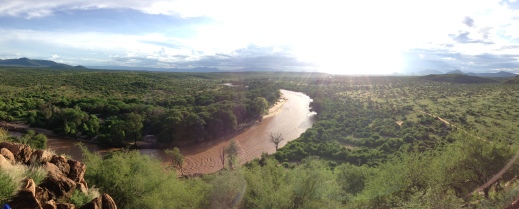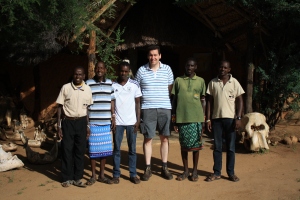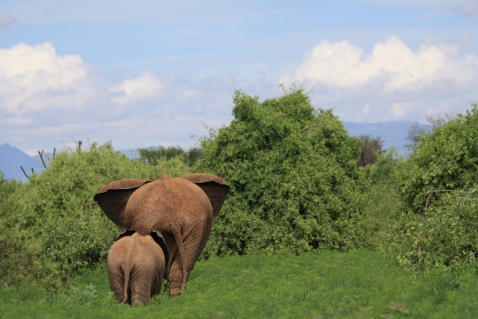Asante Sana!
I have arrived home again yesterday at the end of the day, after an 8 hour flight from Nairobi to Amsterdam. Such a flight gives you a lot of time to think and reflect on the trip. I know that all 3 organisations where happy with my trip, that is what they expressed to me when I left them. I am also grateful for the opportunity they have given me, to give something back. On top of that they have also showed me (again) how beautiful their country is and how privileged I am to have seen the best places of their conservancies.

It is also good to be back home again though. My wife and kids really missed me whilst I was away, so we were all happy to see each other again yesterday evening. I was happy to drive on a motorway on my way home in the Netherlands, during which we did not have to worry about busses overtaking at places where it was impossible. We did not have to worry about people trying to cross a motorway during peak hour traffic. We did not have to worry about potholes that could fit your whole car. We did not have to worry about grasshoppers the size of your hand in the shower room. I could dress myself this morning without having to worry about spiders or scorpions in my clothes or shoes. And during breakfast this morning I was enjoying the simple cheese sandwich instead of the sometime lavish breakfast we got in the conservancies, which made you feel bad being on a volunteering trip 😉
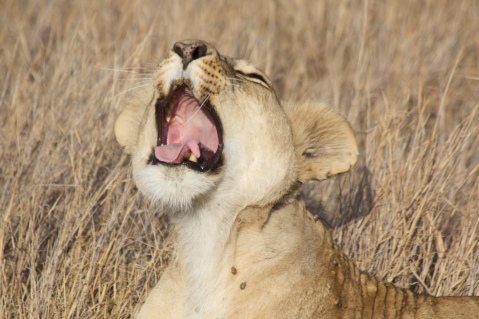
But is all of it really so bad? No it is not. It is the charm of the country and it is what makes a trip like this unique. I am already thinking about my next trip, but next time with the wife and kids as well. I have been told that if I would go next time and not invite them, they would either change the locks according to my wife, or go with me in the suitcase according to the kids. Both of them are not preferable.
Asanta Sana Lewa Wildlife Conservancy, Ol Pejeta Conservancy and Save the Elephants, see you soon!
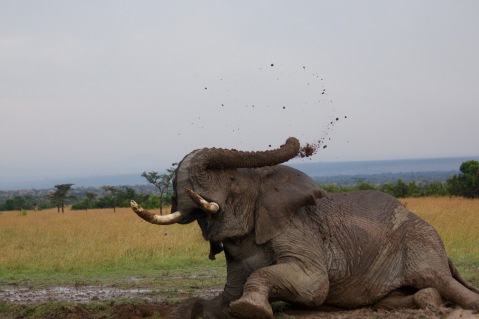
Save the Elephants
I have arrived in Nairobi to do some pro-bono consultancy work with Save the Elephants. The aim is to make them more self-sufficient with things like data loading and report creation on the salesforce platform. We have spent our first day together yesterday, today is our second day and depending on progress we might do a couple of hours tomorrow as well.
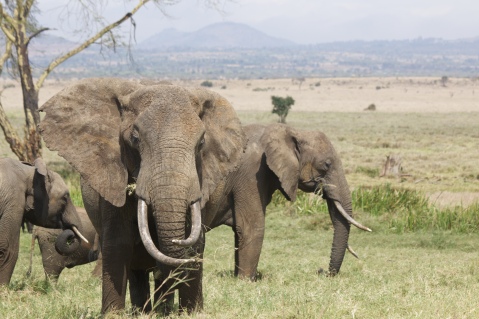
The great thing about spending time with an organisation like Save the Elephants is the stories that you hear about what they are actually doing in the field. Like their project in Tsavo. In that region the government is building a highway and train line, cutting straight across natural walking routes of wildlife, elephants in particular. The construction company will very likely place a fence to stop wildlife, but unless they electrify it, an elephant will just put his bottom against it and he is free to go on both the highway or the train line, with disaster about to happen for both human as well as elephant. Save the Elephants is raising funds to collar up to 10 elephants, so that they can track the exact spot where the cross the roads every time.
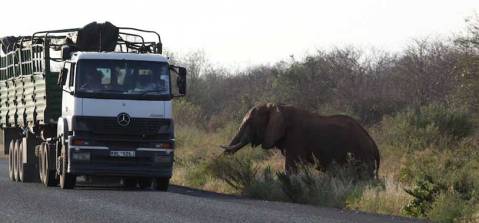
Elephants are really clever and once they have learned a route from the matriarch (most often the oldest female), they will remember it forever. So if those crossings are known, the construction companies can create under- or over-passes for the elephants and other wildlife. This has successfully been done in other areas as well, and clever as elephants are, they make use of these facilities really quickly.
Without the research of Save the Elephants, wildlife corridors might be setup, but most likely in the wrong place, meaning it will not be used and wildlife will create their own crossing with potentially disastrous outcomes. If you want to join their cause, you can donate here.
P.S. the elephant and truck image in this blog is borrowed from the Save the Elephants website
Writers Block, or not?
I have not posted yesterday, and also today I am struggling to write a meaningful post. I can share loads of stories and pictures about my game drive, but you would almost think I am not on a volunteering trip but on a holiday.
We have done a road trip again today, moving from Ol Pejeta to Nairobi, where I will be with Save the Elephants the coming days. We are staying over in Wildebeest Eco Camp, a very nice luxury campground, or so called glamping. I stayed over this same place 3 years ago, and it has changed a lot. the restaurant and some of the tents are still there, but a pool has been added, and also various other tents and cottages where you can stay over.
One of the most striking things I have seen at Ol Pejeta in the previous days, was a rhino cemetery. All rhino’s who died by since 2004 by poaching have been buried at that cemetry.
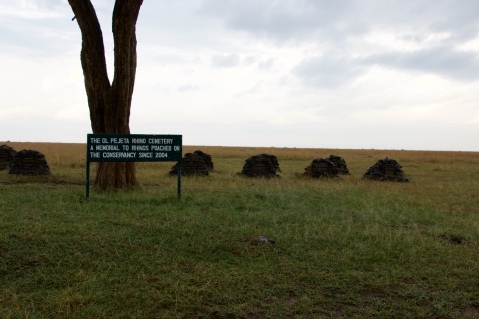
Even though these animals are supposed to be in a save conservatory, still people would enter it illegally and kill the rhino for its horn. Most plates on the graves mention a shot rhino with both horns removed. And all of that since there are still so many people on this world who think that the horns can be medicinal, whilst the material is almost exactly the same as someone their fingernails. It is a lot cheaper to buy a clipper and cut your own nails and grind them, instead of killing such magnificent creatures in such a way, that they are becoming extinct in years if nothing changes, and we would not be able to see things like this picture below…
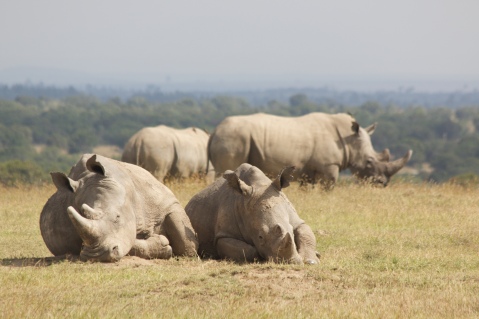
Technology within conservations?
I have had a very interesting day today, looking at how technology can help within a conservancy. At the moment salesforce at Ol Pejeta is mainly used for everything surrounding fundraising, but how can both salesforce technology as well as other technology help within a conservation, whereby internet connectivity is not available at most locations in the park? Some things we discussed are surrounding the endangered species, where sightings, new birth and dead can be registered. The pictures from this morning could mean a deduction in the zebra count, but we noticed that one of the female lions was pregnant:
It could also be used for tracking vet interventions, so that every time a vet is used, this can be traced and linked to the animals. We even brainstormed about using iBeacon or similar devices to hand out to the visitors, and track where they have been, so this could be used for marketing purposes in order to generate more donations. Have you got other ideas, I would love to hear what could be done, so hopefully we can have a discussion on this with Ol Pejeta shortly (maybe even tomorrow). Thanks for participating!
The last Northern White Rhinos
This afternoon we made a visit to the last 3 Northern White Rhinos in existence. There were 4 of them during my previous trip, but one of the male rhinos died a couple of years ago by natural cause.
Ol Pejeta conservancy is housing the last male and 2 females in their endangered species enclosure. This is 17 acres of land within the conservancy where they keep all predators outside and try to let the population of a specific species grow in a natural way. If there are enough they let them out of the enclosure again.
We had the pleasure of feeding Sudan, their 43 year old male, who still gets some additional food like carrots as he has grown used to that during his life in a zoo in the Czech Republic before arriving at Ol Pejeta.
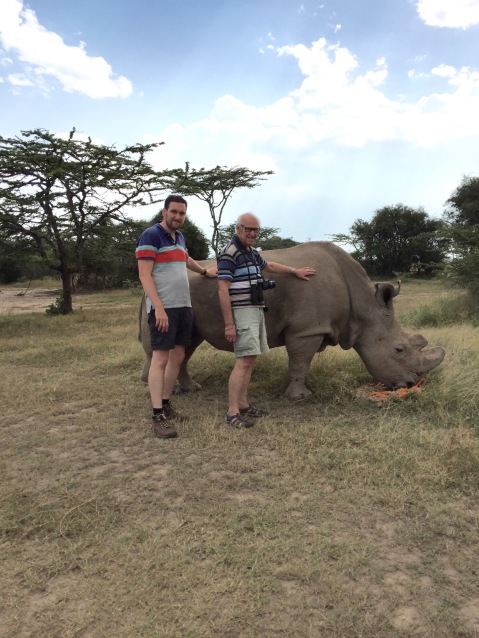
He still is fertile but has really bad back legs which stop him from mounting a female. The 2 females that they have are mother and daughter. Mother has bad back legs as well, both of them very likely due to sometimes wintery conditions in the zoo in the Czech Republic. So mum cannot give birth because of that. Daughter is missing a uterus, so also cannot give birth. That is why Ol Pejeta has started an IVF program with some leading scientists and use a Southern White Rhino female to carry the embryo up until birth. IVF has never been done with a rhino so a lot of time is spend on figuring out what to do and how to do it. They think they can do the first attempt this year, the picture below shows both female Northern White Rhinos and the female Southern White Rhino who will get the embryo.
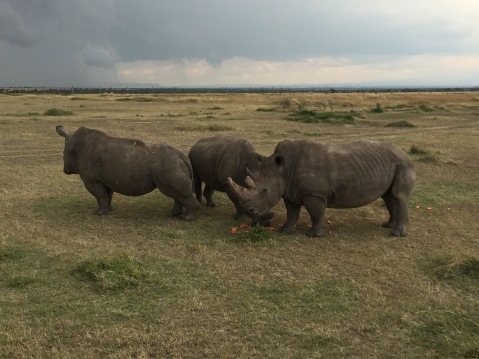
On a trivial pursuit note, did you know that the White Rhino was first discovered by a Dutch person. He described a wide mouth (‘wijd’ in Dutch). Phonetically it is pronounced similarly as white, hence the name.
Tomorrow will be again be a full working day, during which we will also be discussing how we can use technology within conservation. I might share some ideas in my blog post tomorrow.
Working day
My first full day of volunteering today. And even a day like this started relaxed with a morning game drive and a bush breakfast before an 8.30 start. The views again this morning were magnificent, the image below was our bush breakfast view from underneath a flat top acacia!
We have gone over various topics like security, analytics, data quality and best practices. I still have some follow-up work to be done once back home, but I think I have left Lewa’s administrator in a better shape.
During our lunch at our lodge we were joined by the owners of Lewa house, their kids and her parents. After that I had to pack up and head back to the office for the rest of the day. At the end we had a game drive back to the gate, where we were picked up to be brought to Ol Pejeta house.
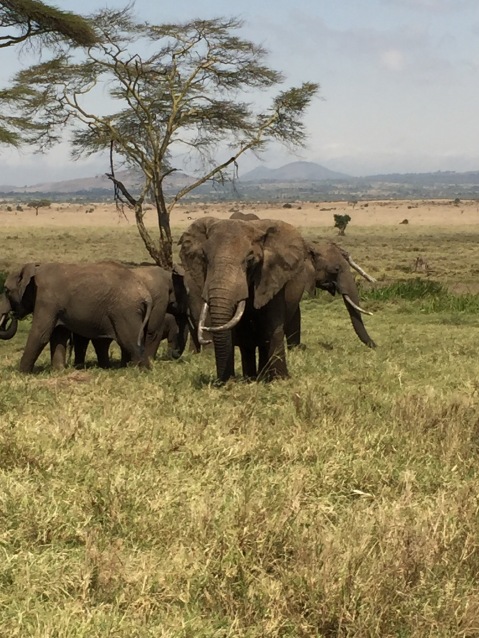
Upon arrival at Ol Pejeta Conservancy we have seen the sometimes chaotic way of communication. The gate was closed and the guards were not expecting us. It took a few phone calls, even though I have seen emails exchanged with license plates from the taxi for a swift arrival. Over at Ol Pejeta House they expected us just after noon, so almost thought we were no longer coming that day. After that all was well and we enjoyed a lovely dinner before moving to our room where I am writing this post. Looking forward to tomorrow where I will find out where they are with Salesforce, and an afternoon trip to the last few Northern White Rhinos on this planet, but more about that tomorrow!
Road Trip
After an 8 hour trip we landed at 6.00 local time this morning at Nairobi International airport. Customs is a lot quicker this year as we could organize our visa via the internet. If only all the people in front of us would have done the same.
Our driver for the day, Sammy, was already waiting for us and we started our roadtrip towards Lewa. The roads have improved a lot in 3 years, cars as well, but most of the lorries are just as old and in hilly terrain holding us up. Gives the time to enjoy the scenery, which is magnificent at times.
 It was very cloudy upon arrival in Nairobi, but the closer to Lewa, the sunnier it gets. The sun is welcoming us!
It was very cloudy upon arrival in Nairobi, but the closer to Lewa, the sunnier it gets. The sun is welcoming us!
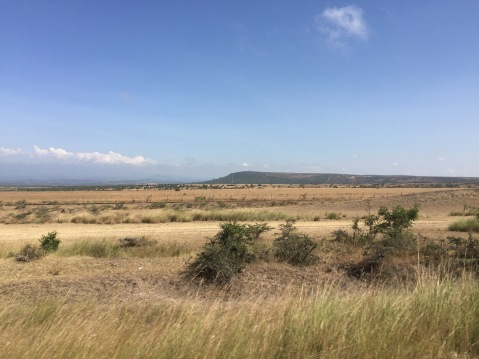
Our arrival at Lewa was again magnificent. The moment you enter the park, there is no longer a rush of cars, time seems to stop. We immediately get to see a lot of wildlife. After a drive to Lewa House, we were welcomed with a lovely lunch, after which I went to Lewa HQ for a discussion with their salesforce administrator about her needs and the agenda for tomorrow. Even though today was mainly planning, I still learned a lot more about their setup and was suprised with some of the advanced setup. Tomorrow will focus on getting more out of their existing data, by for instance using analytics.
After a couple of hours work we ended the day with a game drive, looking at for instance elephants and a close encounter with a rhino.
 We ended in the dark with 2 cheetahs on their way to their evening meal. Talking about evening meals, mine is being served, so I am calling it a day and will be back tomorrow.
We ended in the dark with 2 cheetahs on their way to their evening meal. Talking about evening meals, mine is being served, so I am calling it a day and will be back tomorrow.
Almost back again!
It has been 3 years since my last volunteering trip to Kenya. There was a request for some time to get back as there are lots of outstanding questions and tasks. Not that I neglected Lewa Wildlife Conservancy, Ol Pejeta Conservancy or Save the Elephants, on the contrary. Over the last years I have helped them in various different ways, from data loading to creation of reports and from custom mobile apps to other pieces of configuration.
The contrast however can’t be bigger between Thursday this week and my arrival on Saturday morning in Nairobi. On Thursday I had a partner event organized by ABSI. We played golf at Bergvliet near Oosterhout in the Netherlands. I try to play golf on at least a bi-weekly basis, but this year so far it was mainly trying. Thursday however it still was not playing great (I must confess, I am rather a perfectionist), but well enough for for a Stableford score of 43 and the first prize! I am currently writing this in the plane and tomorrow I know we are driving past the biggest slums of Nairobi, where golf is surely not on their minds. It just makes you realize how happy and thankful we should be in Europe, and should not worry about Brexit or a referendum about an EU treaty with Oekraine, how important these topics can be…
For this trip I have invited my dad to come along. In my very first blogpost of my trip 3 years ago, I mentioned that part of my family had visited before. My mum and dad did so 20 years ago. They visited some of my Uncle his ‘adopted sons’, who stayed in our house when my Uncle died and was buried in the Netherlands. Since my mum died earlier this year, and I had just planned this trip, I asked him if he wanted to join me. He said yes straight away, and here we are sitting in the plane together, preparing for take-off for this adventure. I will keep you posted here.
Pictures will be added in future posts, you can follow me the coming 11 days on this blog!
Back home again
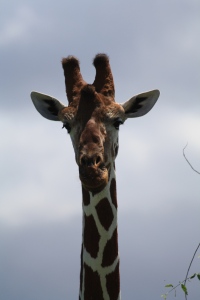 Even if I have returned nearly 2 weeks ago, I have not been in a position to write this final blog post about my adventures in Kenya. My flight back home arrived on Thursday the 2nd of May at 6.00 in the morning and after arrival at home and the handing out of the presents to the kids, my working day started again. I am still playing catch-up since my arrival, as some of the work was just building up and and new work has arrived as well.
Even if I have returned nearly 2 weeks ago, I have not been in a position to write this final blog post about my adventures in Kenya. My flight back home arrived on Thursday the 2nd of May at 6.00 in the morning and after arrival at home and the handing out of the presents to the kids, my working day started again. I am still playing catch-up since my arrival, as some of the work was just building up and and new work has arrived as well.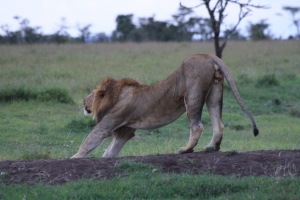
So not a lot of time for reflection yet, also because I am still working with Save The Elephants, Lewa and Ol Pejeta to finalize some of the functionality changes. It has however really been a life changing experience and one that I would not have wanted to miss. I really appreciate the work that these 3 non-profits are doing to ensure that wildlife does not solely move to the local zoo. It such a great experience to see all these beautiful creatures in their natural habitat, and I feel honored and privileged to have helped these organizations. I will continue helping them out for the foreseeable future as well and I will bring my family back to this beautiful country somewhere in the future as well.
How many people work for a company that allows them to do this sort of work and give something back to the world? Thank you very much Salesforce.com and the Salesforce.com Foundation for setting this up and allowing me to have this once-in-a-lifetime opportunity! #Dreamjob
Save the Elephants
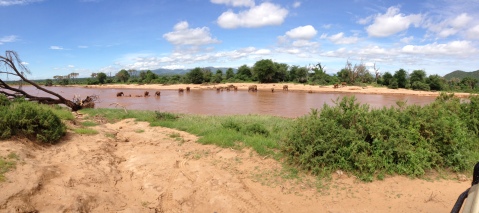 I have spent the previous 2 days looking at the work that Save The Elephants is doing in the Samburu and Buffalo Springs conservancies. I must confess again that I felt privileged to shadow them on their work and see what they are up to. Being allowed to get so close to the elephants (within meters, sometimes nearly touching distance) and observe these magnificent creatures on their daily duties. The area where the camp is located is next to a river. They have had some flooding issues here 3 years ago, but when I arrived the camp was actually in good condition.
I have spent the previous 2 days looking at the work that Save The Elephants is doing in the Samburu and Buffalo Springs conservancies. I must confess again that I felt privileged to shadow them on their work and see what they are up to. Being allowed to get so close to the elephants (within meters, sometimes nearly touching distance) and observe these magnificent creatures on their daily duties. The area where the camp is located is next to a river. They have had some flooding issues here 3 years ago, but when I arrived the camp was actually in good condition.
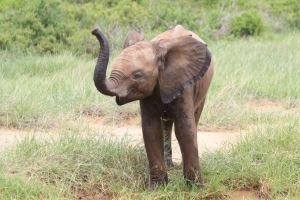
They have 4 full-time researchers at the camp, a couple of students working on PhD studies and the camp crew that ensure the camp is secure and clean, and food is being served as well. All in all 15-20 people will stay at the camp. It is located on the border between Samburu and Buffalo Springs, the river is the divide between them.
The work being done here is largely related to spotting elephants, listing where they were spotted and identifying them. The researchers know many of them by looking at their ears. Each elephant has a distinctive ear pattern with which you can identify them. Since it currently is the wet season, it was pretty easy to spot them as they were moving along in large groups. During dry season, they have smaller groups in which they move around and could therefore also be harder to spot.
![]()
Some of the elephants have tracking devices around their neck. With the data this device sends out, it is possible to identify moving 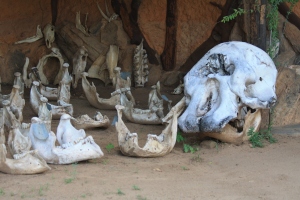 behaviors and the results of that could be used to further increase security in certain areas to stop poaching.
behaviors and the results of that could be used to further increase security in certain areas to stop poaching.
Poaching is currently the biggest threat to the survival of the Elephant in the wild. They are still being killed and their ivory tusks taken away so that people can use to carve figurines or other things out of it. But the people that are buying this should realize that they are not buying a piece of ivory on its own, they are also buying the death of an elephant, and sometimes even more if the main female is killed and other elephants become orphans (and potentially die because of that as well). Having seen these lovely and peaceful creatures and having been able to witness what they were doing just makes me mad that people kill them only for their tusks. There are so many other things you can put on display on top of your fireplace, for which you don’t need to kill an animal like this!
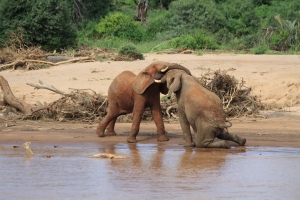
Will the 2 elephants below live long enough to enjoy the beauty of Africa? If it is down to Save The Elephants they will be able to do so, but they will need our support in stopping poaching as well.




